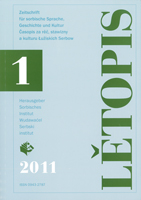Niektóre aspekty kryzysu w serbołużyckim ruchu narodowym
Some Aspects of the Crisis in the Sorbian National Movement in 1946/47
Author(s): Piotr PałysSubject(s): History
Published by: Domowina-Verlag GmbH / Ludowe nakładnistwo Domowina
Keywords: national movement; 1946; 1947; Domowina; national; committees; slav; committee; politics; All-Slav; congress; Belgrade; Sorbian; Sorbs
Summary/Abstract: The Sorbian national movement after the end of the Second World War consisted of three main organisational centres: the Domowina, the national committees with the National Council at their head and the Slav Committee. These bodies pursued different approaches to the solution of the Sorbian question. The integration of Domowina representatives into important political functions achieved their goal of cooperating with the local German authorities and keeping Lusatia as part of Germany. The other Sorbian bodies, which in part had their headquarters abroad, continued to press for the separation of Lusatia from Germany. However, they were gradually pushed to the political sidelines with this policy. While there was still cooperation between the different Sorbian groups in 1945/46, contacts between the bodies were gradually abandoned. This led to a double strategy, which caused some confusion abroad. In December 1946 two Sorbian delegations took part in the All-Slav Congress in Belgrade. In March 1947 the Sorbian representatives put together two memoranda with different aims for the Allied Foreign Ministers’ Conference. This led the Sorbian post-war movement into a crisis. The Domowina emerged from this strengthened and developed increasingly into the central Sorbian organisation. It cooperated with the German political authorities, above all the SED. The Sorbian National Council by contrast rejected any cooperation with the German parties until its enforced dissolution in 1948.
- Issue Year: 2011
- Issue No: 1
- Page Range: 60-76
- Page Count: 17
- Language: Polish
- Content File-PDF

